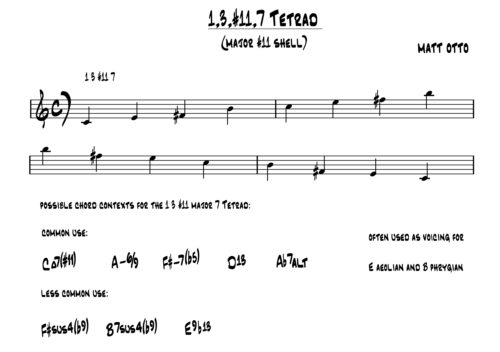Using only the 1,3,#11,7 Tetrad (or 4 note set)
I’ve been using this 1, 3, #11, 7 Tetrad (4 note set) for years in both composition (voicings for big band or small group part writing) and as a group of notes to improvise from.
The 1, 3,#11, 7 tetrad is sometimes referred to as a Major 7 b5 (or #22) shell voicing. Using this sort of “parallelism” through a progression as an approach for improvisation of voicing chords is often used by Kurt Rosenwinkle, Larry Koonse and many others.

This 1, 3, #11, 7 Tetrad has many possible harmonic contexts, here are a few:
1. For Major 7th chords, build the tetrad off the root.
2. For minor 7th chords, build the tetrad off the b3.
3. For half diminished 7th chords (or sus b9), build the tetrad off the b5.
3. For dominant 7th chords (with nat 9, #11, 13 or lydian dominant), build the tetrad off the b7.
4. For dominant 7th chords (with #5 and #9 or altered dominant), build the tetrad off the natural 3
5. For phrygian minor, build the tetrad off the b2.
6. For aeolian minor, build the tetrad off the b6.
.
Below I’ve written a one chorus etude over the progression to “What is This Thing Called Love”. This Etude uses only the 1, 3, #11, 7 Tetrad on every chord for the note content. I’ve introduced rhythm and phrasing to create interest. Both playing through the etude and improving with each specific tetrad over the progression will help you assimilate the concept and overtime, you should start hearing and implementing some new melodic ideas.
